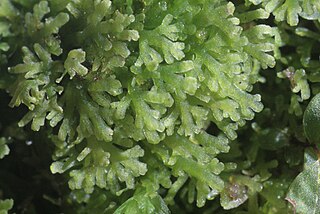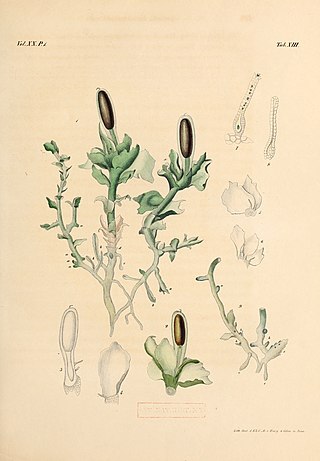
The Marchantiophyta are a division of non-vascular land plants commonly referred to as hepatics or liverworts. Like mosses and hornworts, they have a gametophyte-dominant life cycle, in which cells of the plant carry only a single set of genetic information.

Marchantiales is an order of thallose liverworts that includes species like Marchantia polymorpha, a widespread plant often found beside rivers, and Lunularia cruciata, a common and often troublesome weed in moist, temperate gardens and greenhouses.
The lignans are a large group of low molecular weight polyphenols found in plants, particularly seeds, whole grains, and vegetables. The name derives from the Latin word for "wood". Lignans are precursors to phytoestrogens. They may play a role as antifeedants in the defense of seeds and plants against herbivores.

Gmelina arborea,, locally known as gamhar, is a fast-growing deciduous tree in the family Lamiaceae.

Metzgeriales is an order of liverworts. The group is sometimes called the simple thalloid liverworts: "thalloid" because the members lack structures resembling stems or leaves, and "simple" because their tissues are thin and relatively undifferentiated. All species in the order have a small gametophyte stage and a smaller, relatively short-lived, spore-bearing stage. Although these plants are almost entirely restricted to regions with high humidity or readily available moisture, the group as a whole is widely distributed, and occurs on every continent except Antarctica.

Secoisolariciresinol is an organic compound. It is classified as a lignan, i.e., a type of phenylpropanoid. It is present in some cereals, such as rye, and together with matairesinol has attracted much attention for its beneficial nutritional effects.

Matairesinol is an organic compound. It is classified as a lignan, i.e., a type of phenylpropanoid. It is present in some cereals, such as rye, and together with secoisolariciresinol has attracted much attention for its beneficial nutritional effects.

Haplomitriopsida is a newly recognized class of liverworts comprising fifteen species in three genera. Recent cladistic analyses of nuclear, mitochondrial, and plastid gene sequences place this monophyletic group as the basal sister group to all other liverworts. The group thus provides a unique insight into the early evolution of liverworts in particular and of land plants in general.

Lignan-de-Bazas is a commune in the Gironde department in Nouvelle-Aquitaine in southwestern France.

Lignan-de-Bordeaux is a commune in the Gironde department in Nouvelle-Aquitaine in southwestern France.

Lignan-sur-Orb is a commune in the Hérault département in the Occitanie region in southern France.

Sesamin is a lignan isolated from the bark of Fagara plants and from sesame oil. It has been used as a dietary fat-reduction supplement. Its major metabolite is enterolactone, which has an elimination half life of less than 6 hours. Sesamin and sesamolin are minor components of sesame oil, on average comprising only 0.14% of the oil by mass.

Enterolactone is a organic compound classified as an enterolignan. It is formed by the action of intestinal bacteria on plant lignan precursors present in the diet.
![<span class="mw-page-title-main">Enterodiol</span> Lignan formed by the action of intestinal bacteria on lignan precursors found in plants.[1]](https://upload.wikimedia.org/wikipedia/commons/thumb/e/eb/Enterodiol.png/320px-Enterodiol.png)
Enterodiol is an organic compound with the formula [HOC6H4CH2CH(CH2OH)]2.
Vetaforma is a genus of liverworts found only in Argentina and Chile, and contains a single species Vetaforma dusenii. It is classified in the order Jungermanniales. It was placed as the only member of the family Vetaformaceae within that order, but this family has been merged into the family Lepicoleaceae based on morphological and genetic data. The genus name was originally published in 1960, but this publication was invalid under Article 36.1 of the International Code of Nomenclature for algae, fungi, and plants. The single species was first described in 1900 as Lepidozia dusenii and transferred to Vetaforma in 1962.

Obovatol is a biphenolic anti-inflammatory, anxiolytic, and nootropic isolated from the bark of Magnolia obovata. It is a biphenyl lignan.
Daniel Howard Norris was an American botanist dedicated to the study of mosses, and was a renowned expert on the California bryoflora. The standard author abbreviation D.H.Norris is used to indicate this person as the author when citing a botanical name.
Sticta arachnofuliginosa is a species of foliose lichen in the family Peltigeraceae. Found in Central America and South America, it was formally described by Bibiana Moncada and Robert Lücking in 2012. The type specimen was collected near the Laguna de Chisacá at an altitude of 3,734 m (12,251 ft). The lichen, which usually grows on bark but has also been recorded growing on soil, tends to associates with liverworts from the genera Metzgeria, Lepicolea, Plagiochila, as well as the lichen Heterodermia circinalis. It has been recorded from páramo, and temperate forests at elevations ranging from 2,300 and 4,050 m. The specific epithet alludes to its resemblance to Sticta fuliginosa.

The Setaphyta are a clade within the Bryophyta which includes Marchantiophytina (liverworts) and Bryophytina (mosses). Anthocerotophytina (hornworts) are excluded. A 2018 study found through molecular sequencing that liverworts are more closely related to mosses than hornworts, with the implication that liverworts were not among the first species to colonize land.
Lepicolea is a genus of liverworts belonging to the family Lepicoleaceae.












![<span class="mw-page-title-main">Enterodiol</span> Lignan formed by the action of intestinal bacteria on lignan precursors found in plants.[1]](https://upload.wikimedia.org/wikipedia/commons/thumb/e/eb/Enterodiol.png/320px-Enterodiol.png)

